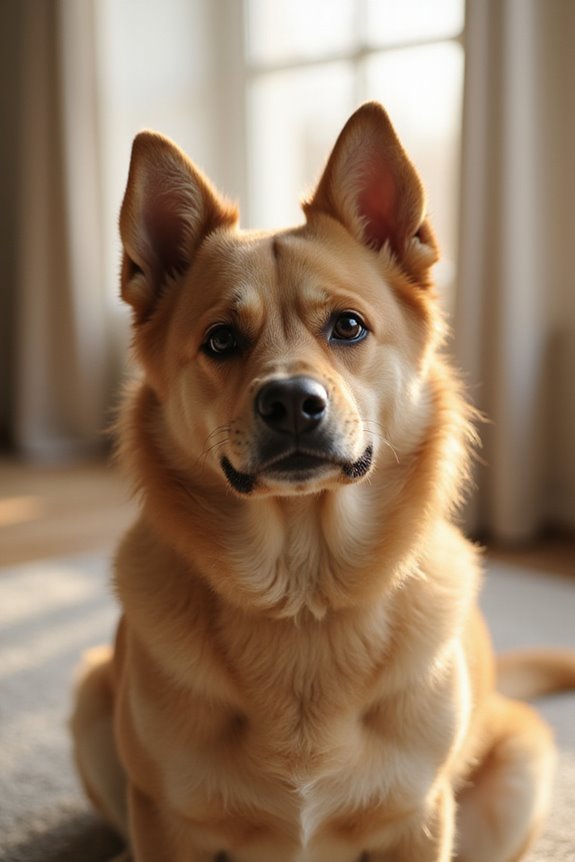If your dog has accidents indoors, first identify potential causes such as medical conditions or behavioral issues. Immediately remove your dog from the area to reduce stress, and clean thoroughly with enzyme-based cleaners. Implement a consistent housetraining schedule and utilize crate training to reinforce good habits. Monitor your dog closely for signs of needing to eliminate, and use positive reinforcement for outdoor success. For ongoing issues, consult a veterinarian or a certified trainer for tailored support and solutions.
Key Takeaways
- Calmly remove your dog from the accident area to reduce stress and confusion.
- Clean the area thoroughly with enzyme-based cleaners to eliminate odors effectively.
- Establish and maintain a consistent housetraining schedule, taking your dog outside regularly.
- Use positive reinforcement to reward your dog for eliminating outside.
- Consult a veterinarian to rule out medical issues causing the accidents.
Identifying the Causes of Indoor Accidents
- Medical Conditions:
- Urinary tract infections can lead to loss of bladder control.
- Chronic kidney disease may increase urination frequency.
- Hormonal imbalances from conditions like diabetes cause excessive urination.
- Canine cognitive dysfunction, similar to dementia, can cause confusion about where to urinate.
- Other neurological diseases may impair bladder control and increase accidents.
Being aware of these potential causes not only helps in addressing the accidents effectively but also aids in ensuring your furry companion receives the care they truly need.
Immediate Actions to Take After an Accident
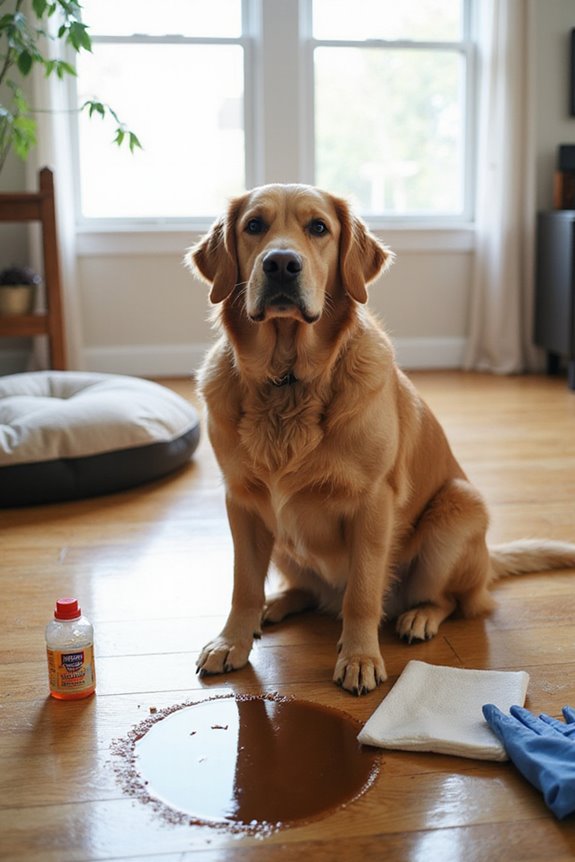
Understanding the causes behind indoor accidents in dogs is just the first step; knowing how to respond immediately after an incident occurs is equally important.
- Calmly Remove the Dog: First, gently take your dog away from the accident area to prevent further stress or confusion. This can also stop them from continuing to eliminate in that spot.
- Clean Thoroughly: Use enzyme-based cleaners to remove odors effectively, avoiding ammonia-based products. Ascertain the area dries completely—repeated cleaning may be necessary to deter further accidents.
- Redirect Outside: Immediately after cleaning, take your dog to their designated outdoor bathroom spot. Praise and reward them if they eliminate there, using positive reinforcement to strengthen the desired behavior.
A proper accident response not only minimizes mess but also helps in reinforcing good habits.
Consistent Housetraining Techniques
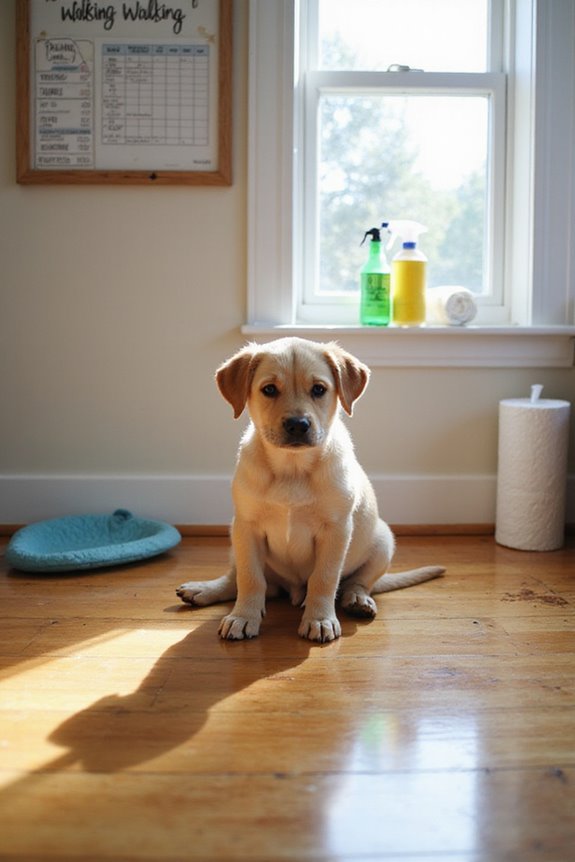
When establishing a consistent housetraining routine for your dog, it’s essential to create a structure that promotes reliable elimination habits. Start by implementing a housetraining schedule, taking your dog outside every two hours, and immediately after eating, playing, or waking up.
- Crate Training: Utilize crate training as a secure space, where dogs naturally avoid soiling. Gradually increase crate time, rewarding calm behavior and feeding meals in the crate to foster positive associations.
- Supervise your dog closely to catch signs of needing to eliminate, and use specific verbal cues like “go potty” to build recognition.
- Reinforce desired behaviors with immediate rewards after outdoor elimination, ensuring they associate the correct location with positive outcomes.
Behavioral Modification and Management
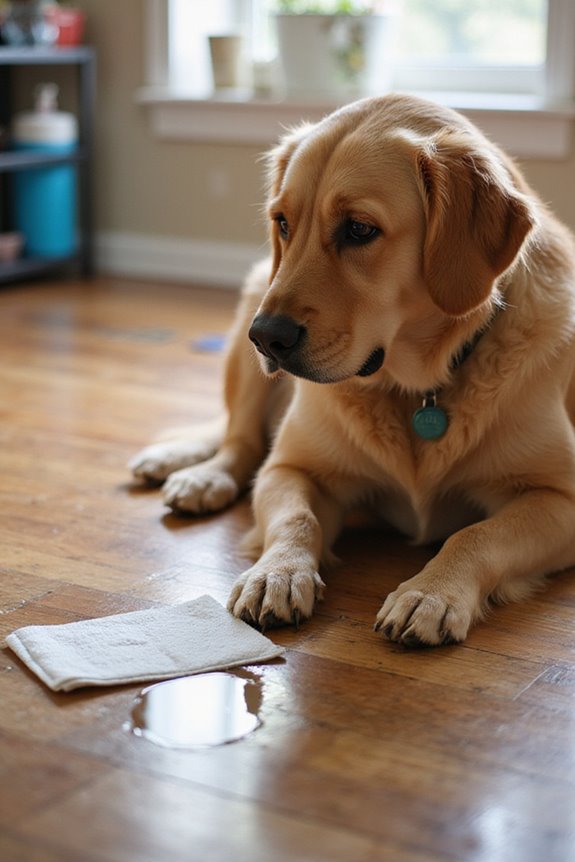
Behavioral modification and management strategies are essential for addressing indoor accidents, especially since many dogs may not instinctively recognize the need to eliminate outside. It’s vital to identify behavioral triggers and implement effective training techniques to assist our dogs in understanding appropriate elimination practices.
- Interruptions and Redirection: Use neutral sounds like “uh-oh!” to interrupt indoor accidents. Immediately guide your dog outside afterward.
- Supervision: Closely monitor your dog to catch elimination postures and prevent accidents with tools like baby gates or crates.
- Counterconditioning: Teach alternative behaviors instead of eliminating indoors, using desensitization to trigger stimuli.
- Crate Training: Utilize crates to reinforce elimination habits, ensuring they feel safe and secure.
This structured approach can help transform your dog’s indoor behavior over time.
Environmental and Routine Adjustments
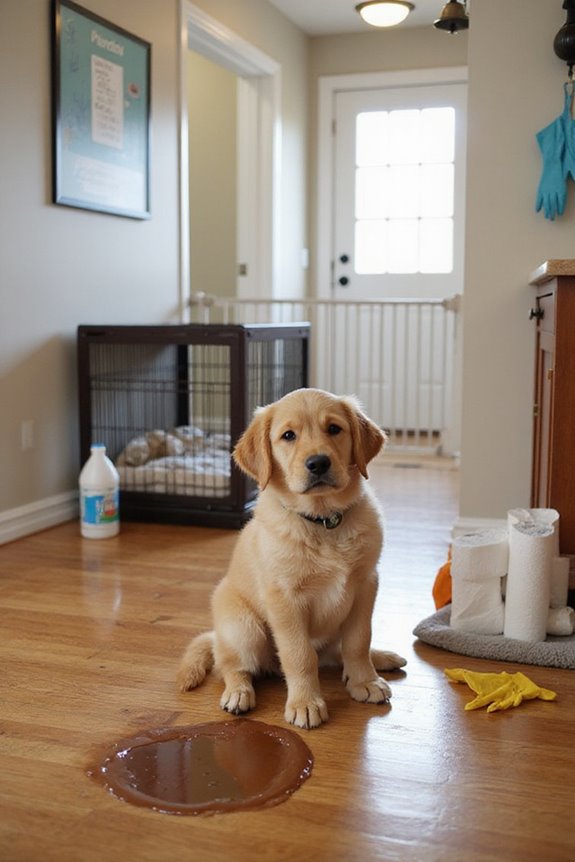
Adjusting your dog’s environment and routine can greatly reduce the likelihood of indoor accidents. Here are a few strategies I’ve found effective:
- Environment Proofing:
- Limit access to bedrooms and areas with rugs by using baby gates.
- Secure or remove items like trash cans and mats to discourage accidents.
- Crate your dog when unsupervised, ensuring it feels like a safe space.
- Establish a daily schedule for feeding and potty breaks.
- Take your dog outside frequently, especially after meals, to reinforce proper elimination habits.
- Use specific cues when it’s time to go, promoting predictable behavior. Incorporating dog training pads can also assist in managing indoor accidents while reinforcing good habits.
- Veterinary Consultation: Sudden accidents can indicate underlying issues like urinary tract infections or diabetes. A vet can perform a urinalysis and check for symptoms like increased water intake or unusual urine color.
- Behavior Assessment: If medical problems are ruled out, consulting a certified trainer or behaviorist may be necessary to address behavioral issues. They can provide tailored strategies suitable for your dog’s health.
Seeking Medical and Professional Support
Addressing persistent indoor accidents often requires seeking medical and professional support, especially if adjustments in routine and environment have not yielded improvements.
Ongoing collaboration between your veterinarian and a behavior professional can create a thorough approach. Regular follow-ups and continuous monitoring of your dog’s health and behavior are essential for effective management and improvement.
Frequently Asked Questions
How Can I Tell if My Dog Is Stressed or Anxious?
When I notice my dog’s body language—like excessive panting, trembling, or avoiding me—I realize anxiety triggers are at play. It’s tough to see them stressed, and I’ve learned to be attentive to these signs.
What Signs Indicate My Dog Might Need Medical Attention?
When I notice unusual behavior or physical symptoms in my dog, like sudden aggression or changes in appetite, I immediately consider getting veterinary help. It’s better to be safe and guarantee they’re well taken care of.
Can Dietary Changes Affect My Dog’s Bathroom Habits?
As the saying goes, “you are what you eat.” I’ve found that dietary adjustments can greatly improve my dog’s bathroom habits, enhancing his digestive health and keeping our indoor spaces accident-free. It’s truly a game-changer!
Is It Normal for Puppies to Have Frequent Accidents?
I totally understand your concern. During puppy training, it’s completely normal to experience frequent urination. Their little bladders just need time to develop. Patience and consistent routines really help them learn where to go.
How Can I Prevent My Dog From Returning to the Accident Spot?
To prevent my dog from returning to the accident spot, I use pee pads and focus on thorough scent removal. It’s essential to eliminate the odors completely; otherwise, they’ll keep going back to that spot.

